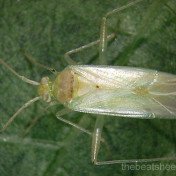In 2019, many of the faba bean crops have growths on pods. There has been much debate over the years about the cause/s of the lumps seen on the pods of faba beans; with some attributing it to thrips, or more recently to green mirid feeding. The growths are called oedema or intumescences, and are caused when the uptake of… Read more »
UPDATE (1 October 2019): High numbers of moths are still being reported in this region. Continue to check soybean crops for this pest. Reports have come in of major soybean moth activity in winter-planted soybeans in the Burdekin and Mackay regions. Some of the outbreaks caught all concerned by surprise, and one report came from a crop barely 10 days… Read more »
The yearly Helicoverpa spp. pheromone trapping program for the Northern Grains Region, run by the Queensland Department of Agriculture and Fisheries (DAF), has recently commenced. During the first few weeks of trap catches, trap operators have detected flights of both H. punctigera and H. armigera in pheromone traps across the Northern Region (Table 1). Table 1. Latest Helicoverpa spp. pheromone… Read more »
While drought has dashed the planned rotations of many growers, there is still a risk of pest outbreaks at this time of year. Below are some of the most common to keep an eye out for. A note on withholding periods following insecticide use in crops that are diverted to stock If insecticide treatments have been applied to crops which… Read more »
With current rainfall so uncertain, there is the potential for crop failures this season. If these crops are cut for hay, or grazed, it is critical that the withholding period (WHP) of any insecticide treatments are considered. The WHP is the minimum period that needs to elapse between the last use of the product and the harvesting or cutting of… Read more »
Armyworm infestations of barley crops, in particular, are being reported from southern NSW to the Darling Downs. Large numbers of moths are also being seen around lights at night. It is not unexpected that armyworm would be abundant this spring as some of their source areas (Channel Country, North Western Queensland) would have received significant rainfall or flows earlier in… Read more »
Outbreaks of Bruchidius mackenziei (unofficially called the soybean bruchid) have been reported recently in soybean crops in the South Burnett and North Queensland. The bruchids were detected at harvest and postharvest, their timing matching previous reports of this pest from the Darling Downs and Burnett in 2009/10. Bruchidius mackenziei is a native bruchid that is most likely not a true… Read more »
Green lacewing larvae are generalist predators, and are important natural enemies of a range of pests including aphids, helicoverpa, whitefly and mealybugs. There are many species of green lacewings in Australia, including some that commonly occur in field crops. Readers are most likely to be familiar with Mallada signatus, which regularly features in ID guides, but another species, Plesiochyrsa ramburi… Read more »
After the introduction of Bt cotton in the 1990s, the focus of cotton pest management has shifted to sucking pests. Green and brown mirid (Creontiades spp.) damage can occur at any stage, from seedling to boll filling, although crops are usually attacked before peak flowering. Feeding damage (including terminal death, abscission of young squares and bolls, and lint damage in… Read more »
Significant soybean moth flights have been observed recently in some coastal Burnett soybean crops. Little damage has been observed to date, but high numbers of adult moths are an early warning sign of potential severe defoliation. Soybean moth is usually a minor soybean pest but in spasmodic major outbreaks, larval populations can exceed 1,000 per square metre. Identification Soybean moths… Read more »










